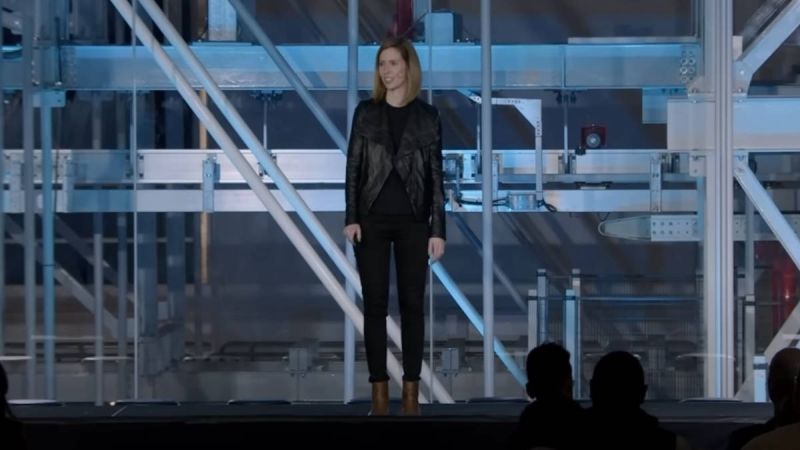Tesla Supercharging and This Woman
The Tesla Supercharger Network started off with just a few chargers in California and has grown significantly since then. The success is in large part to this woman: Rebecca Tunnici, the Senior Directory of charging at Tesla. She spoke at Tesla's Investor Day about charging and had this to say:
Recently, Tesla opened up their network on a global basis to other vehicles. 50% of Tesla Superchargers in Europe are open to other vehicles. Asia Specific just opened up their first sites in Australia. North America and the U.S. just opened their first sites to other vehicles.
Tesla is building their generation 4 Superchargers, and these have longer cables in order to reach the vehicle.
Tesla's Supercharger network has introduced the "magic dock", a CCS adapter that is hidden in a box that the normal Tesla plug is inserted into. For Tesla owners charging, they won't know the difference, but for a non Tesla EV, the CCS adapter will come out already plugged into the Tesla plug. It's a genius piece of engineering.
You may also be interested in:
- Tesla 'Most Profund AI Company' In the World.
- Like a Giant Sports Car - the Tesla Model X Plaid.
- How regenerative braking works in EVs.
Future of Tesla Supercharging
The Tesla Supercharger Network is a network of fast-charging stations for electric vehicles owned and operated by Tesla Inc. The Supercharger stations are designed to allow Tesla owners to quickly charge their vehicles and extend their range for long-distance travel.
The network was launched in 2012 and has since grown rapidly, with thousands of Supercharger stations now located across the globe. It is expected to continue to grow well into the year 2030.
Early Days of the Tesla Supercharger Network
The Tesla Supercharger Network was first launched in 2012 with a single Supercharger station located in California. The station was initially only available to Tesla employees but was later opened to the public.
At the time, the Supercharger station could charge a Model S to 50% battery capacity in just 30 minutes, allowing drivers to travel up to 170 miles on a single charge.
As demand for the Supercharger network grew, Tesla began to expand the network to other locations across the United States.
By the end of 2013, there were already 9 Supercharger stations located in California, Nevada, and Arizona.
In 2014, Tesla began to expand the network globally, with the first international Supercharger station opening in Norway. Since then, the network has continued to expand, with Supercharger stations now located in over 40 countries around the world.
Expansion and Upgrades
As the Tesla Supercharger Network continued to grow, Tesla made significant upgrades to the charging technology. In 2016, Tesla introduced the Supercharger V2, which increased charging speeds to 120 kW, allowing drivers to charge their vehicles in less time.
In 2019, Tesla introduced the Supercharger V3, which further increased charging speeds to 250 kW and allowed drivers to charge their vehicles at rates of up to 1,000 miles per hour.
Tesla also began to expand the Supercharger Network beyond long-distance travel. In 2017, Tesla introduced urban Superchargers, which are designed for use in cities and other urban areas. These Superchargers have lower power output than the standard Superchargers, but they are designed to be more compact and easier to install in urban environments.
Tesla has also begun to install Supercharger stations at destination locations such as hotels and shopping centers, allowing Tesla owners to charge their vehicles while they shop or stay overnight.
Expected Growth until 2030
As Tesla continues to expand the Supercharger Network, the company has set ambitious goals for the future. With more than 40,000 Superchargers today, it stands to reason that there could be well over 80,000 by the year 2030.
To achieve this goal, Tesla will need to continue to rapidly expand the Supercharger Network. The company has already made significant progress towards this goal, with the over 40,000 Supercharger stalls currently in operation globally.
In addition to expanding the network, Tesla is also likely to continue to upgrade the technology, with even faster charging speeds and more advanced features.
The growth of the Tesla Supercharger Network is also likely to be driven by the increasing adoption of electric vehicles and especially opening up charging to non Tesla EVs.
As more people switch to electric vehicles, the demand for charging infrastructure is likely to increase. Tesla is well-positioned to take advantage of this trend, given its already extensive Supercharger Network and its reputation for high-quality charging technology.
I think Tesla will get to 80,000 and possibly 100,000 Supercharger stalls by 2030. It might even be much higher than this, as Tesla plans to have a 20 million per year vehicle run rate by then. That's about 10x the current rate. The number could be closer to 400,000 Supercharger stalls.
What do you think of Tesla Supercharging and Rebecca Tunnici? Has she played a hand in the growth and development of it?
In Related News: Tesla's 3-Part Ecosystem
Leave your comments below, share the article with friends and tweet it out to your followers.
Jeremy Johnson is a Tesla investor and supporter. He first invested in Tesla in 2017 after years of following Elon Musk and admiring his work ethic and intelligence. Since then, he's become a Tesla bull, covering anything about Tesla he can find, while also dabbling in other electric vehicle companies. Jeremy covers Tesla developments at Torque News. You can follow him on Twitter or LinkedIn to stay in touch and follow his Tesla news coverage on Torque News.











